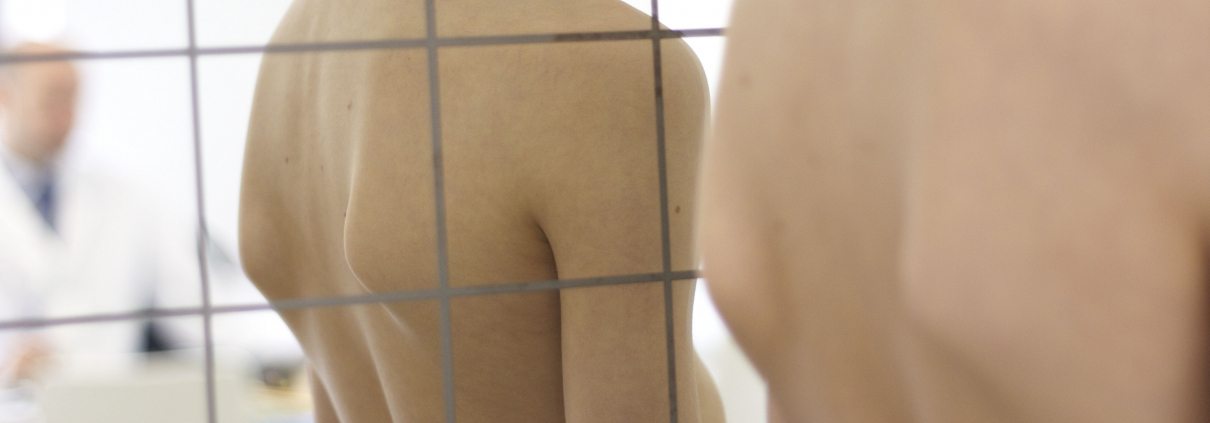Surgical Scoliosis: when to operate
In the presence of a curve measuring more than 50 Cobb degrees, scoliosis is termed “surgical”. Unfortunately, the likelihood of surgical scoliosis worsening, even in adults, and giving rise to pain, disability and reduced quality of life, is very high.
What to do when scoliosis occurs in young children (0-3 years) and in cases of juvenile scoliosis (3-12 years)
Being typically associated with a high potential for worsening, infantile and juvenile scoliosis have, in the past, always tended to be considered surgical cases from the outset. Today, though, we know that there may be some hope of avoiding surgery in these cases, provided the affected individual adheres to a lengthy course of conservative treatment that begins with the onset of the scoliosis and ends only when he/she has finished growing. Conservative treatment is often recommended in the early stages of scoliosis in any case, even when there is a very high likelihood that surgery will eventually be required.
In such cases, this initial conservative treatment is a means of supporting these young patients until they reach the moment deemed most opportune for performing the surgery, which, in this way, will consist of a single and definitive operation.
What to do when scoliosis is already surgical in adolescence (12-14 years)
In early adolescence, when the process of bone maturation is not yet complete, a scoliotic curve is at very high risk of worsening. If the affected youngster has never previously tried an appropriate conservative treatment programme (full-time bracing and specific exercises), it may well be worth considering pursuing this avenue and then, together with the medical specialist, re-assessing the situation in the light of the results achieved after the first few months of treatment.
We already know that a scoliotic curve classed as surgical can often be stabilised, and sometimes even improved, through conservative treatment.
Conservative treatment is, as we constantly stress, very protracted and demands considerable commitment and many sacrifices. But it is also a treatment with a beginning and an end, which means that, sooner or later, the brace will become a thing of the past! When young patients, together with their parents, decide to go down this route, it is crucial that their decision is, as far as possible, an informed choice.
For this reason, it is important that they consider speaking to a specialist surgeon (which is not to say that they will automatically be put on a waiting list for the operation!). The decision on whether or not to be treated surgically remains an entirely personal one, but, in order to make it, patients and families need to be informed of the risks and benefits of the operation, and informed about the most innovative surgical techniques available, and about the post-surgical recovery: how long it will take and what to expect.
Given that it is impossible to know, beforehand, whether the benefits of the surgery will ultimately justify this course of action, only armed with all this information is it possible to make a truly informed decision.
What to do about surgical scoliosis in 17-20 year olds
Young people reach bone maturity by late adolescence/early adulthood. At this age, therefore, the risk of growth-related worsening of scoliosis disappears.
Conversely, there is still a risk that the condition may worsen as a result of likely instability of the curves, which remains.
Scoliosis surgery is never a life-saving procedure, and therefore should never be treated as an emergency.
It is always useful to seek the opinion of a surgeon, but there is no reason why the patient, having done so, should not choose to wait, taking the time to verify, through periodic checks with his/her medical specialist, the stability, or otherwise, of the situation.
Should an evolution of the curve occur, it will still be possible to undertake a specific course of exercises and assess, over time, whether these are sufficient to stop further progression of the curve, before deciding whether or not to opt for surgery.
What to do about surgical scoliosis in adults
In adults, the extent of the curve, measured in Cobb degrees, is no longer the main parameter considered when deciding whether or not to opt for surgery.
When examining X-rays taken in adults, attention is paid mainly to the sagittal plane, given that adults (unlike youngsters) are more likely to develop a more forward-bent posture.
The other parameters to be taken into consideration are pain, disability and quality of life. Given that the surgery carries risks, and it is not possible to know in advance whether the benefits of the surgery will be great enough to justify choosing this course of action, in adults it tends to be chosen only in the presence of a highly debilitating level of pain that is seriously compromising the patient’s quality of life.
In this case, too, it is possible first to undertake a specific conservative treatment, in order to monitor how, over time, it affects the stability of the curve and the level of pain and disability. In this way, the possibility of surgery can be weighed up in the light of its results.



Leave a Reply
Want to join the discussion?Feel free to contribute!